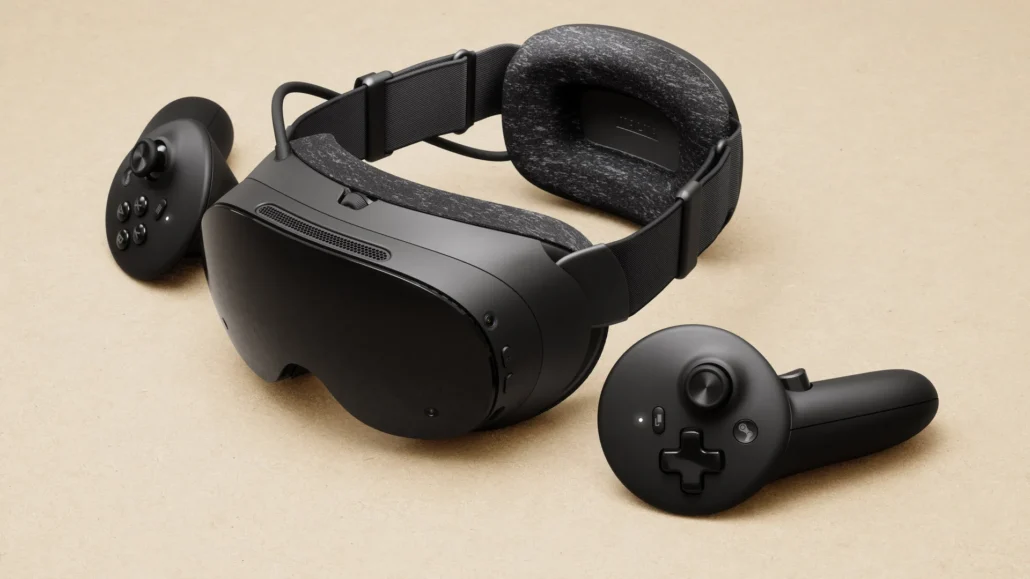Valve has officially lifted the curtain on a trio of major hardware announcements: the Steam Machine, a compact console-style PC; the Steam Frame, a standalone VR headset; and a redesigned Steam Controller. All three products are set to launch in early 2026, signaling Valve’s most ambitious hardware expansion since the Steam Deck.
The goal is clear: build an entire gaming ecosystem around SteamOS that connects the living room, VR, and desktop environments. With this lineup, Valve is attempting to position Steam not just as a store, but as a platform spanning multiple ways to play.
The reveal follows months of speculation, but today’s announcement provided full technical details, design previews, and a look at how each device fits into Valve’s strategy for the next generation of PC gaming.
Steam Machine

The Steam Machine is Valve’s new living-room centerpiece, designed to blend console convenience with the power and flexibility of a PC. Its minimalist cube design is roughly the size of an Xbox Series S, featuring soft edges, a front USB-C port, and an understated glowing Steam logo that doubles as a power indicator. It’s built for plug-and-play gaming, supporting everything from native SteamOS titles to Windows games running through Proton.
Under the hood, the hardware represents a massive jump from the Steam Deck’s architecture. The six-core AMD Zen 4 CPU and RDNA 3 GPU combination delivers up to six times the Deck’s processing power, allowing for native 4K resolution and higher framerates across demanding games like Cyberpunk 2077 and Baldur’s Gate 3. The 16 GB of DDR5 RAM ensures smooth multitasking, while the additional 8 GB of GDDR6 VRAM keeps texture-heavy games running without bottlenecks.
Cooling has been re-engineered with a dual-fan setup and heat-pipe array designed to maintain consistent thermals under load without jet-engine noise. Valve claims it can sustain full GPU boost speeds without throttling, even after extended play sessions. The system runs SteamOS 3, the same Linux-based operating system that powers the Steam Deck, giving users instant access to their full library and cloud saves.
Connectivity options are futureproof, with Wi-Fi 6E, Bluetooth 5.3, and both DisplayPort 1.4 and HDMI 2.1 outputs supporting up to 8K @ 60Hz. The Steam Machine also syncs wirelessly with the new Steam Controller and Steam Link app, allowing users to transition from desk to couch instantly.
Valve confirmed the system will come in 512 GB and 2 TB NVMe configurations, with a tool-free expansion bay for SSD upgrades. A quick suspend-and-resume feature lets players pause mid-game and resume within seconds, similar to what’s seen on the Steam Deck. The company is positioning it as the first “living-room PC” that feels as simple as a console, but without sacrificing control, customization, or access to the broader PC ecosystem.
Specifications:
- CPU: Custom AMD Zen 4 6-core / 12-thread processor, up to 4.8 GHz, 30 W TDP
- GPU: Custom AMD RDNA 3 with 28 compute units, up to 2.45 GHz, 110 W TDP
- RAM: 16 GB DDR5 system memory + 8 GB GDDR6 VRAM
- Storage: 512 GB or 2 TB NVMe SSD with microSD expansion
- Display Outputs: DisplayPort 1.4 (up to 4K@240Hz or 8K@60Hz) and HDMI 2.1 (4K@120Hz)
- Connectivity: Wi-Fi 6E, Bluetooth 5.3, built-in wireless adapter for Steam Controller
- Form Factor: Compact cube design (~6 inches per side, 2.6 kg)
- Operating System: SteamOS 3 (Linux-based)
- Release Window: Early 2026
Steam Frame

The Steam Frame is Valve’s boldest move into virtual reality since the Index, combining the comfort of a standalone headset with the freedom of wireless PCVR streaming. The headset’s sleek, curved chassis and lightweight build (440 grams with strap) mark a departure from the heavy, front-loaded designs of older VR systems. Its improved weight distribution and memory foam padding make it more comfortable for extended sessions, while a built-in cooling vent ensures internal temperature stays manageable during high-performance rendering.
Powered by Qualcomm’s Snapdragon 8 Gen 3 chip, the Steam Frame can run native games directly from SteamOS VR without a tethered PC. That means VR classics like Beat Saber, Superhot VR, and Half-Life: Alyx (optimized for standalone mode) can run without an external rig. When connected wirelessly to a gaming PC via Wi-Fi 7, the headset unlocks higher fidelity through SteamVR streaming, delivering near-lossless visuals at up to 144 Hz.
The dual 2160×2160 LCD panels and pancake lenses deliver exceptional clarity, while eye-tracking and dynamic foveated rendering reduce GPU strain by prioritizing the region where you’re looking. The four outward-facing cameras handle inside-out positional tracking with precision, and two inward-facing cameras enable accurate eye tracking for gameplay and interface navigation.
Steam Frame controllers feature capacitive touch sensors and adaptive triggers, combining the ergonomics of the Index controllers with the flexibility of the Meta Quest Pro’s design. The controllers charge via magnetic docking and are tracked natively by the headset without requiring base stations.
Steam Frame runs SteamOS VR and integrates directly with the Steam ecosystem, allowing users to browse their full library, stream desktop apps, or mirror PC gameplay. Valve has emphasized its goal to make VR feel more accessible without compromising depth, and early impressions suggest this could be the company’s most balanced headset yet—bridging standalone accessibility and PCVR power.
Specifications:
- Processor: Qualcomm Snapdragon 8 Gen 3 (4 nm ARM64)
- RAM: 16 GB unified LPDDR5X
- Storage: 256 GB or 1 TB UFS with microSD expansion
- Display: Dual LCD panels (2160×2160 per eye), pancake lenses, 72–144 Hz refresh rate
- Tracking: Inside-out tracking (4 external cameras + 2 internal eye-tracking sensors)
- Connectivity: Wi-Fi 7, Bluetooth 5.3, USB-C port, 6 GHz wireless adapter
- Weight: 440 g (with strap), 185 g headset core
- Operating System: SteamOS VR
- Release Window: Early 2026
Steam Controller (2nd Generation)

The new Steam Controller has been completely overhauled to improve comfort, reliability, and precision. While it retains the iconic dual-trackpad layout from the original, every component has been redesigned. The frame now feels closer to an Xbox Elite controller in size and weight, with textured grips and soft-touch triggers for improved ergonomics.
The addition of dual magnetic TMR thumbsticks is one of the most significant upgrades. These sticks use tunnel magnetoresistance sensors that eliminate drift, a problem that plagues traditional analog sticks. Each stick features adjustable tension and haptic feedback for more tactile resistance during gameplay. The controller’s expanded rear grip buttons are programmable through Steam Input, allowing users to map functions or macros across all supported platforms.
The dual haptic trackpads remain a defining feature, offering mouse-like precision for strategy, simulation, and FPS titles. Combined with gyro aiming and “Grip Sense” (which activates motion controls only when held firmly), the new controller caters to both casual players and competitive PC gamers.
Connectivity is also far more flexible. The controller can connect via Bluetooth, USB-C, or an ultra-low-latency 2.4 GHz wireless “Puck” adapter that supports up to four controllers simultaneously. Valve claims up to 35 hours of battery life per charge, and the rechargeable lithium pack is user-replaceable.
Valve intends the Steam Controller 2 to unify input across its ecosystem, from the Steam Deck to the Steam Frame. It can switch seamlessly between devices via Steam Cloud Profiles, saving mappings and sensitivity settings automatically.
Specifications:
- Thumbsticks: Dual magnetic TMR sticks (resistant to drift)
- Trackpads: Dual haptic trackpads for precision cursor control
- Additional Inputs: ABXY buttons, D-pad, triggers, bumpers, four rear grip buttons, gyro sensors with Grip Sense
- Connectivity: Bluetooth, USB-C wired, 2.4 GHz wireless via Puck dongle (supports up to four controllers)
- Battery Life: 35+ hours per charge
- Compatibility: Steam Deck, Steam Machine, Steam Frame, and PC
- Release Window: Early 2026
Together, these three devices mark a major turning point for Valve. The Steam Machine challenges consoles directly, offering a simpler way to access PC gaming in the living room. The Steam Frame expands Valve’s reach into the growing standalone VR market while maintaining a tether to high-end PC experiences. The Steam Controller 2 ties it all together, serving as the common interface across the entire ecosystem.
Pricing and regional availability have yet to be announced, but Valve is expected to release those details in early 2026 alongside pre-orders. The company confirmed that it has no immediate plans for a Steam Deck 2, signaling that this new lineup will be the focal point of its hardware roadmap for now.
If Valve executes successfully—balancing pricing, performance, and ease of use—it could redefine what it means to play on PC. The company that once brought gaming to your desktop is now bringing it to your couch, your hands, and even your field of view.
But the biggest question still looms: how much will it all cost?
Valve’s history suggests aggressive pricing to undercut competitors, but with the high-end specs on display, affordability could determine whether this ecosystem thrives or stays a luxury niche. Until those numbers drop, excitement will be mixed with one thing every gamer feels before a big launch—curiosity, and a bit of anxiety about what the price tag will say.




